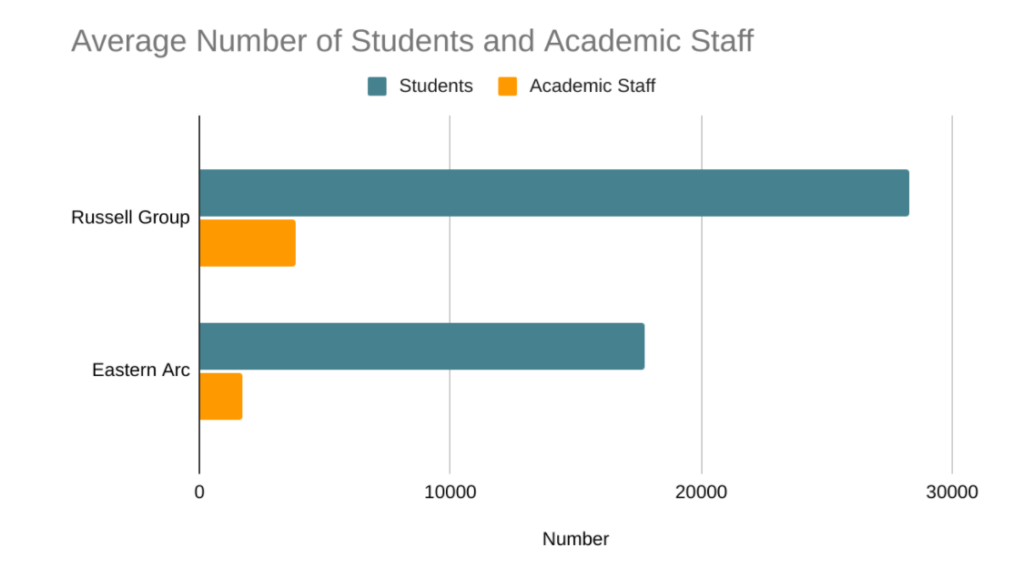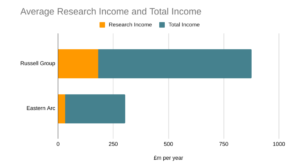EARC submits response to Nurse Review
04 March 2022
Eastern Arc has submitted a response to the review currently being undertaken by Prof Sir Paul Nurse, the Director of the Crick Institute.
The review is intended to safeguard what the Government sees as ‘the manifest strengths of the RDI system across the UK and nurture its diversity, ranging from the pipeline of pioneering, visionary blue-skies research through to practical support for innovators to commercialise their ideas.’
It will explore the features and characteristics of this ecosystem, compare it with those internationally, and produce recommendations for it going forward.
The full text of our response is given below, and is available as a pdf here.
A Response to the Nurse Review of the UK Research Landscape
Eastern Arc, the regional research consortium comprising the universities of East Anglia, Essex and Kent, welcomes the Government’s intention ‘to build on the manifest strengths of the RDI system across the UK and nurture its diversity, ranging from the pipeline of pioneering, visionary blue-skies research through to practical support for innovators to commercialise their ideas.’
It recognises the value of the current review led by Prof Sir Paul Nurse to assess the current state of the research environment in the UK, to learn from those that exist in other countries, and to suggest ways in which the landscape can be made sustainable and cost-effective.
Given the work that has already been undertaken by the Review, we will not go into any detail in comparing the UK to other countries; rather, we will use our response to highlight the specific experience of our regional universities, what has worked and what hasn’t, to raise some concerns but also to set out some positive thoughts on a way forward.
A divided landscape
We are conscious of the clear and significant divisions within the RDI landscape of the UK, and are concerned that these are widening through recent policy and funding.
Despite the idealistic intentions of both the Robbins Report of 1963 and the Further and Higher Education Act of 1992, and the resultant democratisation of higher education in the UK, there is a significant divide within research and innovation.
The establishment of a self-selected group of Russell Group (RG) universities in 1994 has exacerbated this divide, creating a ‘Matthew Effect’ whereby richer, larger and more research-active universities become even more so.
Both explicitly and implicitly, this division is clear in the development of policy and the distribution of funding. In a recent analysis of Hesa data undertaken by EARC, we compared the average size (in both overall income, research income, student number and staff number) of an RG university and an EARC university. These are shown in the charts below.


The EARC universities, as ‘typical’ multi-disciplinary pre-92 universities, are broadly a third the size of their RG counterparts in terms of overall income, and a fifth in terms of research income. The difference in staff-student ratios can also be seen, which may increase the capacity at RG universities for academics to have more time for undertaking research.
Implicitly, the disproportionate profile and power of RG universities is demonstrated clearly in the Scoping Group for this review: of the seven members, four are currently involved in research in the UK; of these, three are based at RG universities, the fourth being at the Crick. Those members educated in the UK received either their UG or PG training (or both) at an RG university. There is no current representation of MissionPlus, GuildHE or the S10 universities within the group.
This is not to question the invaluable experience, knowledge and insights that the members bring; this is indisputable. Rather, for a review seeking to enhance ‘the diverse mix of RDI-performing organisations’, it is a demonstration of existing structural inequalities.
The value of the specific size, skills, location and knowledge of non-RG universities
We believe that, although there is some merit in ‘concentrating’ research in very large, metropolitan universities, there is a significant danger in doing so. There is strength in diversity, and value through effective networks of excellence. As the last two Research Excellence Frameworks have emphasised, there is a need to ensure ‘that excellent research continues to be well-supported wherever it is found.’
The Eastern Arc universities are an example of this. In mapping our common strengths at the start of the second iteration of our consortium (2020-25), we undertook an analysis of field-weighted citation impact (FWCI) and the REF2014 results for our three member institutions.
In terms of the former, an example of specific strengths include public health, health services and primary care: the universities had a mean FWCI in this area of 2.41, and more than double the average number of publications. For REF2014, social work, social policy and sociology were significant areas of strength, with all three EARC universities in the top quarter nationally, and UEA and Kent in the top 8%.
It is important not only to recognise such specific strengths, but also to understand how these strengths are used to enable, engage and galvanise innovation and interdisciplinary research.
Given the size and location of the EARC universities, this creativity and flexibility is more easily achieved. It enables more cross-fertilisation across disciplines as departments and the campus as a whole tend to be smaller, but it also enables the universities to be essential anchors, facilitators and connectors within the region.
In particular, we wish to highlight three examples:
- The Norwich Research Park. UEA is co-located on the NRP with world-leading research institutes including the John Innes Centre, the Quadram Institute, the Earlham Institute and the Sainsbury Laboratory. In being part of this fertile, creative crucible – but not dominating it – UEA is part of a reciprocal and productive relationship that pushes forward the boundaries of knowledge, but also encourages and enables innovation and a productive collaboration with the private sector.
- Knowledge Training Partnerships. Funded by Innovate UK, KTPs enable businesses to engage with academic research through graduate ‘KTP associates’. By doing so, strong, robust and sustainable collaborations are made between researchers and the commercial sector, but they also train, encourage and support graduates in engaging with innovation. The University of Essex is the UK’s number 1 institution for hosting KTPs, demonstrating its strong innovation-focused outlook and ability to mobilise knowledge transfer on a regional basis.
- ‘Enabling Innovation: Research to Application (EIRA). Funded by Research England, this project further demonstrated the value of regional knowledge exchange. Providing funding to catalyse links between world-leading research and regional business, the programme also brought together and harnessed the focused areas of research within smaller regional institutions, including Writtle and the Norwich University of the Arts.
There are many more such examples that demonstrate the value of flexible cooperation and collaboration between recognised beacons of research excellence within smaller regional institutions.
The future
Although we recognise that the Review is focused on ‘the landscape of organisations that deliver research rather than on mechanisms for funding research,’ the two are inextricably linked.
As such, it would be difficult to identify ways ‘to secure an organisational landscape…that delivers high-quality RDI outputs, and which is sustainable and cost-effective’ without addressing the ways in which research is funded.
Our concern, then, is that the Review will only tell half the story, and will not be comprehensive enough to give the Government a basis for acting to deliver the change that we believe is necessary.
In terms of what that change should look like, we welcome the analysis within the Government’s recent Levelling Up White Paper, as well as the Nesta report The Missing £4 Billion: Making R&D work for the whole UK. There is a need to think about the current inequalities within the RDI environment – regional and otherwise – and address them.
However, we would go further: it is not as simple as just moving money out of the ‘greater South East’, but rather to think about how funding can be more effectively used to support smaller centres of excellence and the networks that exist between them, wherever they exist.
More broadly, there is a need to address the implicit bias in Government policy-making that favours larger, metropolitan universities. Those universities belonging to MillionPlus, GuildHE, S10 and other mission groups should be actively engaged and consulted in the development of national policy.
Research (for example Petrescu 2019, Swartz et al 2019 or Freeman & Huang 2014) has shown that ‘diversity enhances excellence and innovation’. An RDI environment that recognises and supports a wide diversity of centres and strengths, voices and viewpoints, is more likely to catalyse new thinking, and challenge and question accepted paradigms. It is only by doing so that we will ensure the vitality of our research, and ‘futureproof the UK landscape [to] ensure an agile and sustainable system that can respond to future priorities and developments.’
18 February 2022
Image: “National Portrait Gallery, Paul Nurse” by alh1 CC BY-NC-ND 2.0.
